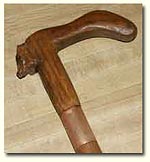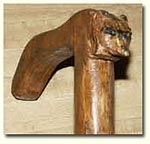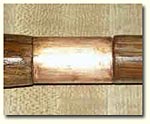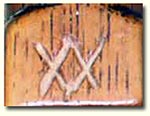
|
Restoration ServicesArtisans of the Valley employs their knowledge of antique furniture restoration towards the repair and restoration of walking sticks and canes. Details on our qualifications will soon be featured on this site, please check our parent website for our museum affiliations and restoration gallery. We'll work on any wooden cane, stick, or staff to repair carving, cracks, finishes, etc. We can also provide cleaning and minor repair services on metal pieces. If you have an heirloom piece in need of attention, we would be happy to evaluate it and determine if a restoration of feasible. These photos illustrate a restored hand carved country oak cane, mainly the replacement of broken and missing handle with appropriate wood handle. The original carver appears to have had considerable skill; the geometric patterns are very precise. Our client's estimate of circa 1810 is substantiated by the carving patterns, which were popular during this period. The remaining piece of the original handle appears to have been amber or fake amber composite. This was most likely not the original handle, perhaps added in the late 18th to early 19th century. Amber, or fake amber, was not readily available in North America in the early 1800's, and it is unlikely a country craftsman, especially if it was made in Arkansas, would have access to this material. We suspect the original handle was replaced do to damage, or the cane was updated to conform to "modern" styles of the 19th century. This material is a poor choice for a cane handle, as it is brittle and most remaining examples are damaged or missing pieces. The handle design selected is appropriate to the style of the cane,
as per examples shown in our reference library. In addition, we
chose to add the face of a raccoon to the front of the handle. Repairs were completed using oak, appropriate to the original material, with a copper ferial to strengthen and hide the joint. This was a common practice for the time using brass, tin, silver, or copper - in rare cases gold. Copper was the most common and available to country craftsman, so we selected it for this restoration. The copper patina was aged to conform to the piece; it should NOT be polished.
The "XX" carved on the cane could possibly indicate the age of
the original owner as per the client's family story. Artisans estimates the value of this piece, now restored, between $500 and $1000 when compared to similar pieces sold at auction. |
||||||||||||||||||||||||||||||||
Artisans of the Valley Hand Crafted Custom Woodworking Stanley D. Saperstein Eric Saperstein Our studio and showrooms are open by appointment. Please call ahead so we don't miss you! (609) 637-0450 Fax (609) 637-0452 e-mail: woodworkers@artisansofthevalley.com |




